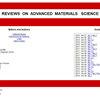Friction stir welding of dissimilar Al–Mg alloys for aerospace applications: Prospects and future potential
IF 3.6
4区 材料科学
Q2 MATERIALS SCIENCE, MULTIDISCIPLINARY
引用次数: 0
Abstract
Friction stir welding (FSW) is increasingly utilized in aerospace for welding dissimilar Al–Mg alloys without melting, overcoming fusion welding challenges. This summary highlights FSW’s key aspects for dissimilar Al–Mg alloys and its aerospace relevance. These alloys are widely used in aerospace due to their beneficial properties, but fusion welding faces issues like brittle intermetallic compounds (IMC) and decreased mechanical properties. FSW addresses these challenges by using a rotating tool to generate frictional heat, plasticizing the material for solid-state joining without melting. This reduces IMC formation, enhancing joint strength and mechanical properties. Critical parameters like rotational speed, traverse speed, tool design, and process variables are emphasized for optimal FSW of dissimilar Al–Mg alloys. Joining these alloys is crucial in aerospace for applications such as aircraft structures, engine components, and fuel tanks. FSW offers advantages like weight reduction, improved fuel efficiency, and structural integrity enhancement. It allows welding dissimilar Al–Mg alloys with varying compositions for tailored material combinations meeting specific needs. In conclusion, FSW of dissimilar aluminum alloys is promising for aerospace, creating defect-free joints with improved mechanical properties. However, further research is needed to optimize parameters, explore tool designs, and validate long-term performance in aerospace environments.用于航空航天的异种铝镁合金搅拌摩擦焊:前景和未来潜力
在航空航天领域,搅拌摩擦焊(FSW)越来越多地用于焊接异种铝镁合金,无需熔化,克服了熔化焊接的难题。本摘要重点介绍了搅拌摩擦焊用于异种铝镁合金的关键方面及其与航空航天的相关性。这些合金因其良好的性能而被广泛应用于航空航天领域,但熔焊却面临着金属间化合物(IMC)变脆和机械性能下降等问题。FSW 通过使用旋转工具产生摩擦热,使材料塑化,在不熔化的情况下进行固态连接,从而解决了这些难题。这减少了 IMC 的形成,提高了连接强度和机械性能。本文强调了旋转速度、横移速度、工具设计和工艺变量等关键参数,以优化异种铝镁合金的 FSW。在航空航天领域,连接这些合金对于飞机结构、发动机部件和燃料箱等应用至关重要。FSW 具有减轻重量、提高燃料效率和增强结构完整性等优点。它可以焊接不同成分的异种铝镁合金,以定制材料组合满足特定需求。总之,异种铝合金的 FSW 在航空航天领域大有可为,它能焊接出无缺陷的接头,并提高机械性能。不过,还需要进一步研究,以优化参数、探索工具设计并验证在航空航天环境中的长期性能。
本文章由计算机程序翻译,如有差异,请以英文原文为准。
求助全文
约1分钟内获得全文
求助全文
来源期刊

Reviews on Advanced Materials Science
工程技术-材料科学:综合
CiteScore
5.10
自引率
11.10%
发文量
43
审稿时长
3.5 months
期刊介绍:
Reviews on Advanced Materials Science is a fully peer-reviewed, open access, electronic journal that publishes significant, original and relevant works in the area of theoretical and experimental studies of advanced materials. The journal provides the readers with free, instant, and permanent access to all content worldwide; and the authors with extensive promotion of published articles, long-time preservation, language-correction services, no space constraints and immediate publication.
Reviews on Advanced Materials Science is listed inter alia by Clarivate Analytics (formerly Thomson Reuters) - Current Contents/Physical, Chemical, and Earth Sciences (CC/PC&ES), JCR and SCIE. Our standard policy requires each paper to be reviewed by at least two Referees and the peer-review process is single-blind.
 求助内容:
求助内容: 应助结果提醒方式:
应助结果提醒方式:


